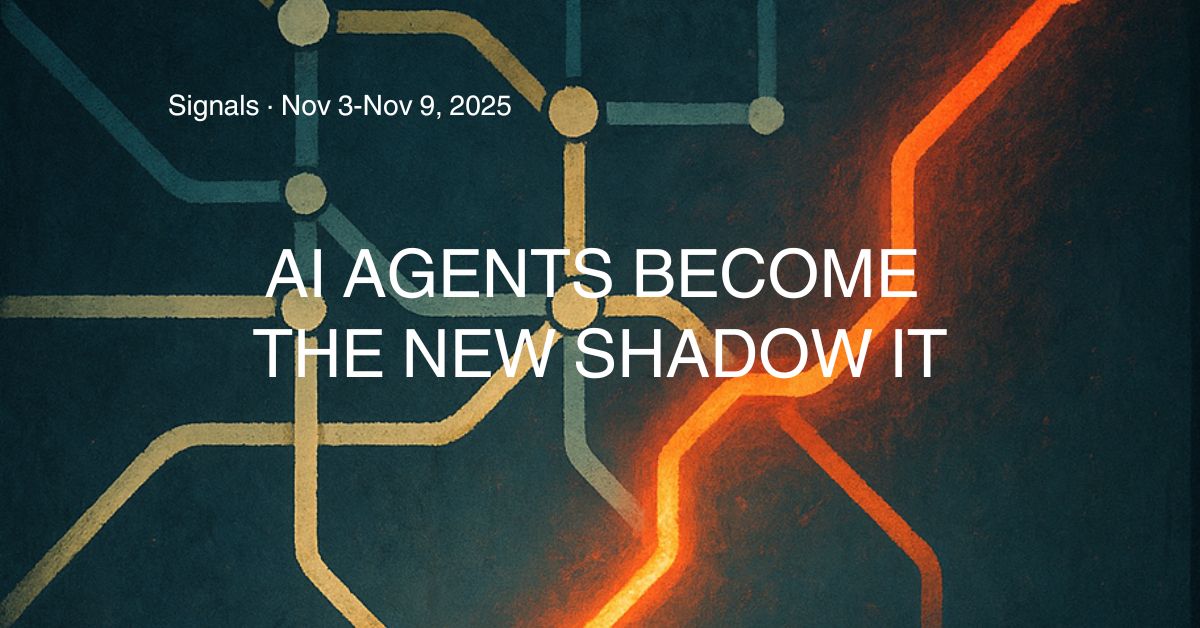- Internal AI agents are spreading inside organizations without oversight, creating an invisible layer of automation that sits outside traditional identity and audit frameworks.
- Most agents inherit human permissions, keep long-lived tokens, and bypass MFA entirely, making them a governance and accountability gap, not a model-safety issue.
- Regulators are now treating automated decisions as accountable actions, which forces companies to track agent identity, lifecycle, and impact as rigorously as human users.
- A new category is emerging: AI Access Governance – the inventory, identity, and control plane for internal agents.
Shadow IT 2.0
Across many organizations, AI adoption has moved from pilots to quiet, incremental habits. Teams build small agents to automate reporting. Product managers wire LLMs into internal dashboards. Engineers stitch assistants into CI or Jira. Marketing runs micro-automations for content clean-up and enrichment. None of these projects looks significant, and that’s exactly the problem.
They accumulate.
As a result, most companies are running more internal agents than they realize. These agents pull data, update records, trigger workflows, and interact with SaaS tools using human-grade permissions they inherited from whoever built them. They don’t show up in IAM dashboards. They don’t appear in access reviews. They don’t get offboarded when employees change roles. And because they authenticate with tokens, not people, they operate completely outside MFA.
Companies didn’t lose control. They never applied it in the first place. And we’ve seen it before with SaaS products creating the (in)famous Shadow IT.
Internal AI agents simply fall between frameworks: too “technical” for business governance, too “experimental” for IT, and too “low risk” for security. As a result, organizations have created a parallel automation layer that behaves like a digital workforce but exists with no HR file, no access constraints, and no audit trail.
This is the same pattern that produced Shadow IT, but this time, the actors don’t wait for humans. They run continuously and autonomously.
Why It Matters Now
Three developments converge here.
First, the tools have matured enough that non-technical teams can create and deploy agents without help. What used to require an integration team now takes an afternoon and a good prompt. The friction to produce automation has dropped to near zero.
Second, identity gaps have become impossible to ignore. In most early deployments, internal agents end up running with inherited (user) permissions and long-lived tokens, touching systems that were never meant to be automated. Tokens linger long after creators rotate out. There is no authoritative inventory of what exists, what it can reach, or who is responsible for it.
Third, regulators are shifting expectations. China’s amended Cybersecurity Law, California’s ADMT rules, CMMC enforcement, and early EU interpretations all treat automated decisions as accountable operations. It doesn’t matter whether a human clicked the button or an agent acted programmatically. If the action affects customers, employees, reporting, or risk, companies are expected to demonstrate who (or what) performed it.
This regulatory posture intersects perfectly with operational reality: internal agents already perform business actions every day. And no one can fully explain their lineage.
The governance gap is visible from the moon. Well, maybe not the moon, but definitely from the ISS.
Investor Implications
The pattern is familiar: when adoption races ahead of control, new governance categories emerge.
Just as cloud sprawl created IAM, CASB, CSPM, and later DSPM, AI sprawl will drive a new control plane built specifically for non-human actors operating inside the business.
AI Access Governance is a practical layer focused on inventory, identity, lifecycle, and auditability for internal agents. Not “AI safety,” not “runtime guardrails,” but a system that answers:
- What agents exist?
- Who created them?
- Which systems can they reach?
- What did they do last week?
- How do we revoke them cleanly?
Investors should expect spending to shift from experimental AI features toward controls that reduce operational uncertainty. Audit-grade traceability will matter more than creativity. And vendors able to show lineage, access boundaries, and revocation paths will win enterprise budgets.
Managed service providers will likely step in early. Most organizations don’t have internal maturity for agent lifecycle hygiene, and external help will fill the gap, much like managed identity and managed detection did in the last cycle.
This is the next defensible layer in the AI stack: not model behavior, but agent accountability.
Vendor Implications
Vendors face a structural shift in expectations. Customers will start to ask not only what your AI can do, but also how you keep track of what it has done.
Identity providers will need clear support for agent credentials, scoped permissions, and revocation APIs. Security platforms will need to integrate agent telemetry into their detection logic. SaaS and API-security vendors will be asked to show how agent calls are monitored and constrained. And LLM platforms will have to expose hooks that allow enterprises to enforce policy on agents, not just outputs.
It’s a reframing of trust.
Enterprises want to know which digital actors are touching their systems, under which identity, with what authority, and with what log trail behind them. Vendors that can provide this clarity will separate themselves quickly.
What to Watch Next
Large organizations will eventually need internal agent registries: a source of truth for all automations running inside the business. Early versions will appear as “AI app stores,” where teams can deploy approved agents with controlled identities and standard logging.
Auditors will start asking for evidence of agent actions, not just user actions. Insurers will revise what they consider “controlled access.” And somewhere in the next 12 months, an internal agent will trigger an incident that forces the industry to acknowledge how little visibility companies currently have.
AI agents have become part of daily operations. The governance frameworks around them haven’t, and this gap must close.
